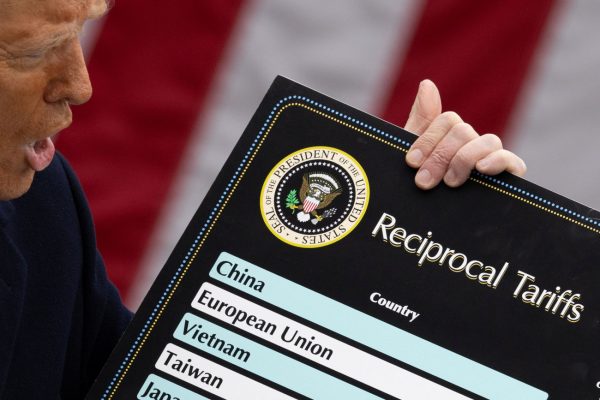
Global growth has been revised downward and inflation projections nudged upward in the latest World Economic Outlook released on Tuesday by the International Monetary Fund (IMF). The fund now expects global GDP to grow by 2.8% this year, a 0.5 percentage point cut from its January estimate.
The IMF attributed the downward revision largely to trade tensions initiated by U.S. President Donald Trump. It warned that tariffs represent a “negative supply shock” that is fueling uncertainty and triggering a “significant slowdown” in global activity.
“In the medium term, we can expect tariffs to decrease competition and innovation, and increase rent-seeking, further weighing on the outlook,” the report noted.
The sharpest downgrade among advanced economies was reserved for the United States. The IMF now expects U.S. growth to reach just 1.8% in 2025, down from 2.7% in January, citing the growing uncertainty caused by escalating trade tariffs.
In the eurozone, where the impact of tariffs has been relatively milder, growth is now forecast at 0.8%, a modest 0.2 percentage point downgrade. Nonetheless, stronger fiscal stimulus in both Europe and China is expected to provide some support through this year and into next.
However, the outlook for emerging market economies remains clouded by volatility in trade policy. The IMF has revised its growth forecast for this group downward by 0.5 percentage points, to 3.7%.
In Greece, growth is projected at 2%, double the eurozone average, though slightly down from the 2.1% estimate in January.
China’s growth forecast has also been trimmed, now estimated at 4%, a 0.6 percentage point drop. Inflation projections for the country were also revised down by 0.8 percentage points.
IMF Chief Economist Pierre-Olivier Gourinchas emphasized the broader structural implications of the ongoing trade tensions.
“The global economic system under which most countries have operated for the last 80 years is being reset, ushering the world into a new era. Existing rules are challenged while new ones are yet to emerge,” Gourinchas said.
He added that since late January, a flurry of U.S. tariff announcements, initially targeting Canada, China, Mexico, and key sectors, culminated in near-universal levies by April 2. The U.S. effective tariff rate has now surged past levels seen during the Great Depression, with retaliatory tariffs from key trading partners compounding the global trade shock.
Source: Tovima.com
Latest News

First Step Towards New Audiovisual Industry Hub in Drama
The project is set to contribute to the further development of Greece’s film industry and establish Drama as an audiovisual hub in the region

Airbnb Greece – Initial CoS Ruling Deems Tax Circular Unlawful
The case reached the Council of State following annulment applications filed by the Panhellenic Federation of Property Owners (POMIDA)

Mitsotakis Unveils €1 Billion Plan for Housing, Pensioners, Public investments
Greek Prime Minister Kyriakos Mitsotakis has announced a new set of economic support measures, worth 1 billion euros, aiming to provide financial relief to citizens.

Alter Ego Ventures Invests in Pioneering Gaming Company ‘Couch Heroes’
Alter Ego Ventures' participation in the share capital of Couch Heroes marks yet another investment by the Alter Ego Media Group in innovative companies with a focus on technology.

Corruption Still Plagues Greece’s Driving Tests
While traffic accidents continue to claim lives on Greek roads daily, irregularities and under-the-table dealings in the training and testing of new drivers remain disturbingly widespread

Pope Francis Died of Stroke and Heart Failure Vatican Confirms
As news of the official cause of death spread, tributes poured in from across the globe. The 1.4 billion-member Catholic Church is united in grief, remembering a pope who championed inclusion, justice, and compassion

Increase in Both Museum Visits, Revenues for 2024
As expected, the Acropolis was the top archeological site in the country, followed by Sounion, Mycenae, the ancient theater of Epidaurus, and Vergina in northern Greece

Where Greece’s Tourists Come From: A Look at 2025’s Top Visitor Markets
The United Kingdom continues to hold the top spot as the largest source of incoming tourism, with 5.6 million seats booked for Greece this summer — up 2.2% from last year. This accounts for 20% of all international air traffic to Greece

Pope Francis: A Pontiff Who Reshaped the Papacy and Sparked a Global Conversation
His first words from the balcony of St. Peter’s Basilica—“Brothers and sisters, good evening”—set the tone for a pontificate that would challenge norms, favor mercy over dogma, and bring the papacy closer to the people.

When Blue Skies was Unmasked as ND’s Political ‘Slush Fund’
The fact that so many top New Democracy (ND) party cadres were paid by the firm Blue Skies, owned by Thomas Varvitsiotis and Yiannis Olympios, without ever citing this publicly, raises very serious moral issues, regardless of the legality












![Πλημμύρες: Σημειώθηκαν σε επίπεδα ρεκόρ στην Ευρώπη το 2024 [γράφημα]](https://www.ot.gr/wp-content/uploads/2025/04/FLOOD_HUNGRY-90x90.jpg)



![Ξενοδοχεία: Μεγάλο το ενδιαφέρον για επενδύσεις στην Ελλάδα – Η θέση της Αθήνας [γραφήματα]](https://www.ot.gr/wp-content/uploads/2025/03/Athens-hotels-90x90.jpg)
























 Αριθμός Πιστοποίησης
Αριθμός Πιστοποίησης